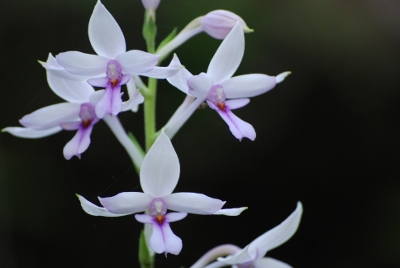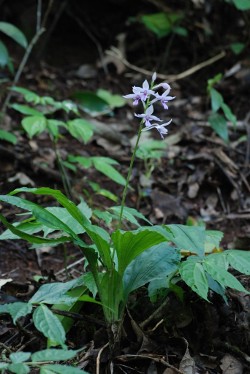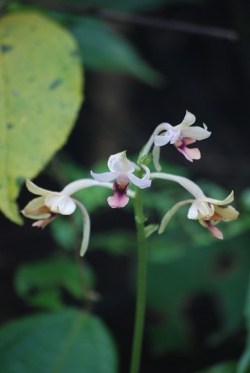Species of the Month – October 2013
Calanthe sylvatica (Thouars) Lindl.
Calanthe R. Brown
A genus of around one hundred eighty sympodial terrestrials or rare epiphytes. The genus gets its name from Greek for beautiful and flower. There are twenty five species distributed across India and of which three are recorded from South India. This genus is distributed from South Africa, Madagascar, throughout tropical Asia and with a single species in tropical America.
In October 1856, first man-made orchid hybrid ever registered was Calanthe dominii. This was a result of a cross between Calanthe masuca (now Calanthe sylvatica) and Calanthe furcata (now Calanthe triplicata) by John Dominy in 1853.
Calanthe sylvatica (Thouars) Lindl.
Synonyms : Calanthe masuca (D.Don) Lindl. Calanthe purpurea Lindl.
A robust plant with large flowers. Flowers are usually 2.5 to 4.5 cms wide,  very variable in size, pigmentation, size and shape of sidelobes and the spur. Flowers are usually white with violet lips or pale violet with deep violet lips or pink with deep pink lips. In all these cases the older flowers turn to bright orange. The spur is 2-4cm long, inflexed, deflexed or straight.
very variable in size, pigmentation, size and shape of sidelobes and the spur. Flowers are usually white with violet lips or pale violet with deep violet lips or pink with deep pink lips. In all these cases the older flowers turn to bright orange. The spur is 2-4cm long, inflexed, deflexed or straight.
The leaves are evergreen. The inflorescence is usually around 50-75cm tall.
Distribution:
Very widely distributed in the Western Ghats particularly towards southern regions. Flourish in the shady floor of the forests at elevation of 1000 to 1400m.
Cultivation:
Though the number of species belonging to this genus is more than 180, only a handful are in cultivation. Calanthe sylavatica is one of them. Calanthe culture is divided into two groups: deciduous and evergreen plants. The first normally have huge pseudobulbs, the evergreen plants have smaller pseudobulbs or completely lack them in some species. Calanthe sylvatica falls into the category of evergreen plants, those that require semi-shaded humus-rich soils on the slopes of woodlands.
 |
 |
Threats: Grazing, habitat destruction due to variety of reasons threaten this beautiful terrestrial species along with the rest of the flora around.
References:
1. Introduction to Orchids by Abraham and Vatsala
2. Illustrated Dictionary of Orchid Genera – The Marie Selby Botanical Gardens.
3. A Catelogue of Indian Orchids – CS Kumar and KS Manilal
Article contributed by : Ravee Bhat